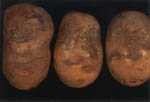
The fungus, Alternaria solani, causes early blight and occurs wherever potatoes are grown. Crop losses can occur if heavy foliar infection takes place around the time of flowering. Disease symptoms first appear as small, brown, pinhead dots on older leaves in the growing crop. These enlarge as concentric rings or "bulls-eye target" causing extensive loss of leaf area and consequent yield reductions. Tuber infection symptoms are seen as dark sunken, generally circular areas surrounded by raised borders that may increase in size during storage. Alternating wet and dry periods are conducive to disease development.

